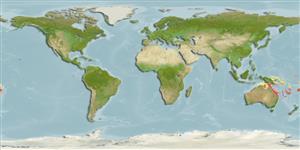>
Eupercaria/misc (Various families in series Eupercaria) >
Labridae (Wrasses) > Bodianinae
Etymology: Choerodon: Greek, choiros = a pig + odous = teeth (Ref. 45335); referrring to the prominent anterior canines of the species in this genus (Ref. 116605).
Environment: milieu / climate zone / depth range / distribution range
Ökologie
seewasser riff-verbunden; tiefenbereich 15 - 40 m (Ref. 86942). Tropical
Western Pacific: Philippines, Queensland, Australia to New Caledonia.
Size / Gewicht / Alter
Maturity: Lm ? range ? - ? cm
Max length : 51.5 cm TL Männchen/unbestimmt; (Ref. 5525)
Rückenflossenstacheln (insgesamt) : 13; Rückenflossenweichstrahlen (insgesamt) : 7; Afterflossenstacheln: 3; Afterflossenweichstrahlen: 10. Body with about 5 to 7 complete broad dusky bands. A distinct dark spot centered on lateral line along dusky band below fifth or sixth dorsal-fin spine. Adults with second prominent anterior canine approximately 1/2 the size of the first, directed mostly dorsally. (Ref 9823)
Adults inhabit lagoon and seaward reefs, usually on rubble and sand bottoms (Ref. 9710) at depths greater than 20 m. Solitary. Feed mainly on hard-shelled prey including crustaceans, mollusks and sea urchins. Oviparous, distinct pairing during breeding (Ref. 205). Relatively common and easily approached (Ref. 9710).
Life cycle and mating behavior
Maturities | Fortpflanzung | Spawnings | Egg(s) | Fecundities | Larven
Oviparous, distinct pairing during breeding (Ref. 205).
Westneat, M.W., 2001. Labridae. Wrasses, hogfishes, razorfishes, corises, tuskfishes. p. 3381-3467. In K.E. Carpenter and V. Niem (eds.) FAO species identification guide for fishery purposes. The living marine resources of the Western Central Pacific. Vol. 6. Bony fishes part 4 (Labridae to Latimeriidae), estuarine crocodiles. FAO, Rome. (Ref. 9823)
IUCN Rote Liste Status (Ref. 130435)
Bedrohung für Menschen
Harmless
Nutzung durch Menschen
Fischereien: weniger kommerziell; Aquarium: Öffentliche Aquarien
Tools
Zusatzinformationen
Download XML
Internet Quellen
Estimates based on models
Preferred temperature (Ref.
123201): 24.5 - 26.6, mean 26.1 °C (based on 42 cells).
Phylogenetic diversity index (Ref.
82804): PD
50 = 0.5000 [Uniqueness, from 0.5 = low to 2.0 = high].
Bayesian length-weight: a=0.01698 (0.00689 - 0.04188), b=3.03 (2.81 - 3.25), in cm total length, based on LWR estimates for this (Sub)family-body shape (Ref.
93245).
Trophic level (Ref.
69278): 4.3 ±0.0 se; based on diet studies.
Widerstandsfähigkeit (Ref.
120179): niedrig, Verdopplung der Population dauert 4,5 - 14 Jahre. (Preliminary K or Fecundity.).
Fishing Vulnerability (Ref.
59153): Moderate vulnerability (41 of 100).
Nutrients (Ref.
124155): Calcium = 34.4 [16.9, 61.0] mg/100g; Iron = 0.469 [0.255, 0.921] mg/100g; Protein = 18.5 [15.6, 20.9] %; Omega3 = 0.109 [0.066, 0.177] g/100g; Selenium = 32.3 [16.9, 63.8] μg/100g; VitaminA = 67.7 [17.0, 325.4] μg/100g; Zinc = 0.894 [0.598, 1.432] mg/100g (wet weight);
